官网操作文档:Elasticsearch Clients | Elastic
踩坑太多了。。。这里表明一下Spring Boot2.4以上版本可能会出现问题,所以我降到了2.2.1.RELEASE。对于现在2023年6月而言,Es版本已经到了8.8,而SpringBoot版本已经到了3.x版本。如果是高版本的Boot在配置类的时候会发现RestHighLevelClient已过时。从官网也可以看的出来RestHighLevelClient已过时。所以这篇博文中不会用到关于RestHighLevelClient的Api。
此篇博文的对应版本关系:Elasticsearch 8.2.0 + Spring Boot 2.7.5。在进入到下面的案例,我需要在这之前先介绍RestClient、RestHighLevelClient、RestClientTransport、ElasticsearchClient。
RestClient
这个类主要是用作于与服务端IP以及端口的配置,在其的builder()方法可以设置登陆权限的账号密码、连接时长等等。总而言之就是服务端配置。


RestClientTransport
这是Jackson映射器创建传输。建立客户端与服务端之间的连接传输数据。这是在创建ElasticsearchClient需要的参数,而创建RestClientTransport就需要上面创建的RestClient。
ElasticsearchClient
这个就是Elasticsearch的客户端。调用Elasticsearch语法所用到的类,其就需要传入上面介绍的RestClientTransport。

引入依赖
<dependency>
<groupId>org.springframework.boot</groupId>
<artifactId>spring-boot-starter-data-elasticsearch</artifactId>
</dependency>
<!-- 高版本还需引入此依赖 -->
<dependency>
<groupId>jakarta.json</groupId>
<artifactId>jakarta.json-api</artifactId>
<version>2.0.0</version>
</dependency>修改yml
需要注意的是账号和密码可以不需要,看自己的Elasticsearch是否有配置账号密码。具体对Elasticsearch的登陆操作可以看:中偏下的位置就是对账号密码的设置。【Linux】Docker部署镜像环境 (持续更新ing)_小白的救赎的博客-CSDN博客
server:
port: 8080
elasticsearch:
hostAndPort: 192.168.217.128:9200 # 低版本使用的
ip: 192.168.217.128
port: 9200
username: elastic
password: 123456
connectionTimeout: 1000
socketTimeout: 30000配置类
这里演示两种情况的配置:第一个代码块是SpringBoot2.4以下 + 7.x版本Elasticsearch的配置。第二个代码块是Spring2.4以上 + 8.x版本Elasticsearch的配置。
@Configuration
public class ElasticConfig extends AbstractElasticsearchConfiguration {
@Value("${elasticsearch.hostAndPort}")
private String hostAndPort;
@Value("${elasticsearch.username}")
private String username;
@Value("${elasticsearch.password}")
private String password;
@Value("${elasticsearch.connectionTimeout}")
private String connectTimeout;
@Value("${elasticsearch.socketTimeout}")
private String socketTimeout;
/**
* create Elasticsearch client
* @return RestHighLevelClient
*/
@Bean
public RestHighLevelClient elasticsearchClient() {
final CredentialsProvider credentialsProvider = new BasicCredentialsProvider();
credentialsProvider.setCredentials(AuthScope.ANY,new UsernamePasswordCredentials(username, password));
ClientConfiguration clientConfiguration = ClientConfiguration.builder()
.connectedTo(hostAndPort)
.withConnectTimeout(Long.parseLong(connectTimeout))
.withSocketTimeout(Long.parseLong(socketTimeout))
.withBasicAuth(username, password)
.build();
return RestClients.create(clientConfiguration).rest();
}
/**
* 将连接传入 Elasticsearch在 Spring Boot的模板类中
* @return 返回 Es的模板类
*/
@Bean
public ElasticsearchRestTemplate elasticsearchRestTemplate() {
return new ElasticsearchRestTemplate(elasticsearchClient());
}
}@Configuration
public class ElasticConfig {
@Value("${elasticsearch.ip}")
private String ip;
@Value("${elasticsearch.port}")
private String port;
@Value("${elasticsearch.username}")
private String username;
@Value("${elasticsearch.password}")
private String password;
@Value("${elasticsearch.connectionTimeout}")
private String connectTimeout;
@Value("${elasticsearch.socketTimeout}")
private String socketTimeout;
/**
* create Elasticsearch client
* @return RestHighLevelClient
*/
@Bean
public ElasticsearchClient elasticsearchClient() {
final CredentialsProvider credentialsProvider = new BasicCredentialsProvider();
credentialsProvider.setCredentials(AuthScope.ANY,new UsernamePasswordCredentials(username, password));
RestClient restClient = RestClient.builder(
new HttpHost(ip, Integer.parseInt(port)))
.setHttpClientConfigCallback(httpClientBuilder -> httpClientBuilder.setDefaultCredentialsProvider(credentialsProvider))
.setRequestConfigCallback(new RestClientBuilder.RequestConfigCallback() {
@Override
public RequestConfig.Builder customizeRequestConfig(RequestConfig.Builder builder) {
return builder.setConnectTimeout(Integer.parseInt(connectTimeout)).setSocketTimeout(Integer.parseInt(socketTimeout));
}
}).build();
ElasticsearchTransport transport
= new RestClientTransport(restClient, new JacksonJsonpMapper());
return new ElasticsearchClient(transport);
}
}控制层
这里为了方便快速入门,就把所有业务代码都放在控制层中了。这篇博文主要是对索引进行操作,所以说获取到ElasticsearchClient后会调用indices()方法,这个方法就是操作索引的方法。次代码块是展示变量以及类注解。后面逐一暂时各个测试代码块Api以及返回结果。
@RestController
@RequestMapping("/es")
@Slf4j
public class EsController{
@Autowired
private ElasticConfig elasticConfig;
}创建索引
/**
* create index
* @return is success?
*/
@PutMapping("/createIndex")
public boolean createIndex() throws IOException {
CreateIndexRequest indexRequest
= new CreateIndexRequest.Builder().index("user").build();
CreateIndexResponse indexResponse
= elasticConfig.esClient().indices().create(indexRequest);
boolean isSuccess = indexResponse.acknowledged();
if(isSuccess) {
log.info("创建索引成功");
} else {
log.info("创建索引失败");
}
return isSuccess;
}查询单个索引数据
/**
* get one index data by id
*/
@GetMapping("/getIndex")
public void getIndex() throws IOException {
GetResponse<User> response = elasticConfig.esClient().get(g -> g
.index("user")
.id("1000")
,User.class
);
if(response.found()) {
log.info("此用户的姓名为,{}",response.source().getUsername());
} else {
log.info("未查询到此用户");
}
}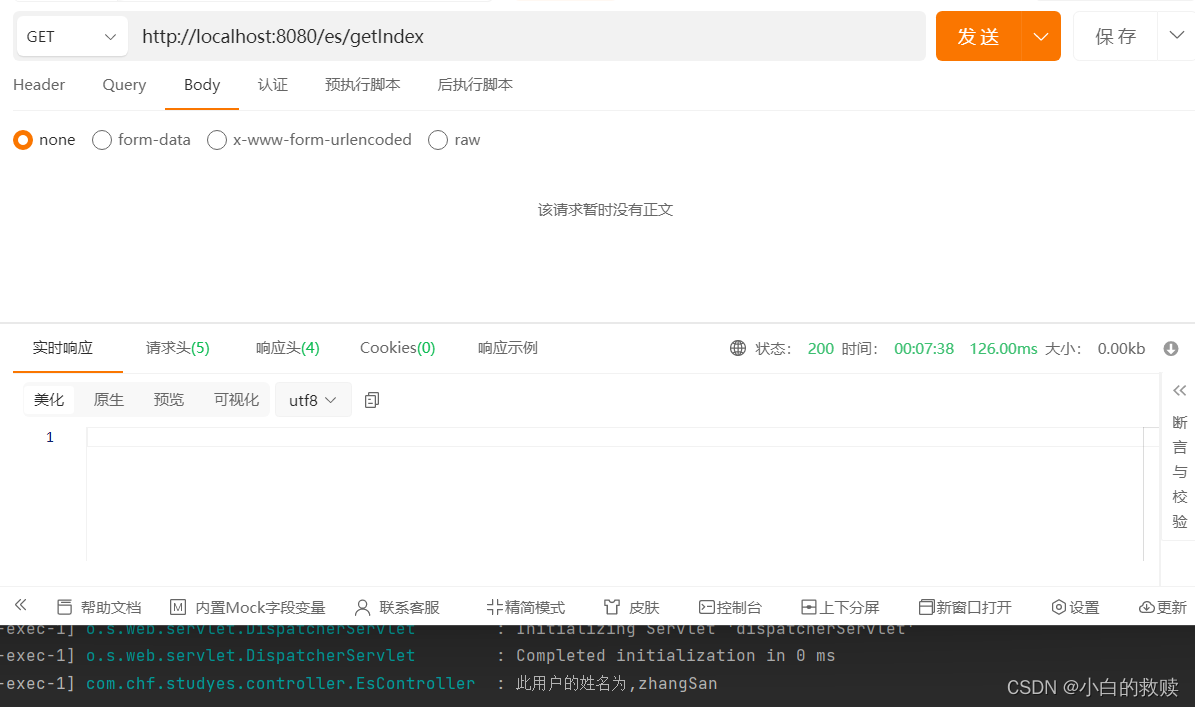
删除索引
这里我测试删除索引成功后又把索引添加了回去。为了后面的其它操作做准备。
/**
* delete one index
*/
@DeleteMapping("/deleteIndex")
public boolean deleteIndex() throws IOException {
DeleteIndexRequest indexRequest
= new DeleteIndexRequest.Builder().index("user").build();
DeleteIndexResponse deleteResponse
= elasticConfig.esClient().indices().delete(indexRequest);
boolean isSuccess = deleteResponse.acknowledged();
if(isSuccess) {
log.info("删除索引成功");
} else {
log.info("删除索引失败");
}
return isSuccess;
}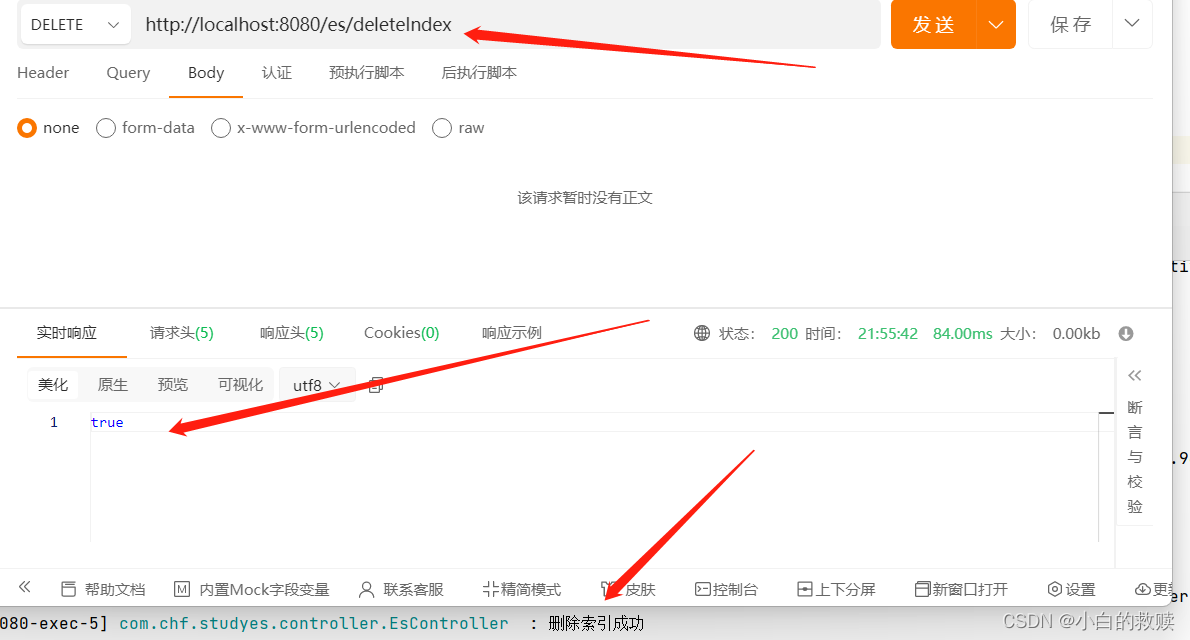
增加索引内容
这里我新增了个实体类,方便添加到索引内容中。这里大概有四种方式可以创建,这里我演示了三种方式,第四种是使用到了ElasticsearchAsyncClient ,这是Elastic异步客户端。
@Data
@AllArgsConstructor
@NoArgsConstructor
public class User {
private String username;
private String sex;
private Integer age;
}/**
* 向索引内容插入数据
*/
@PostMapping("/insertIndexData")
public void insertIndexData() throws IOException {
User user = new User("zhangSan","男",18);
/*
第一种方式:使用DSL语法创建对象
IndexRequest<User> indexRequest = IndexRequest.of(i -> i
.index("user")
.id("1000")
.document(user)
IndexResponse indexResponse = elasticConfig.esClient().index(indexRequest.build());
);
*/
/*
第二种方式:使用Elasticsearch客户端上配置的对象映射器映射到JSON。
IndexResponse indexResponse = elasticConfig.esClient().index(i -> i
.index("user")
.id("1000")
.document(user)
);
*/
// 第三种方式:使用构造器模式
IndexRequest.Builder<User> indexRequest = new IndexRequest.Builder<>();
indexRequest.index("user");
indexRequest.id("1000");
indexRequest.document(user);
IndexResponse indexResponse = elasticConfig.esClient().index(indexRequest.build());
log.info("index,{}",indexResponse.index());
log.info("id,{}",indexResponse.id());
log.info("version,{}",indexResponse.version());
}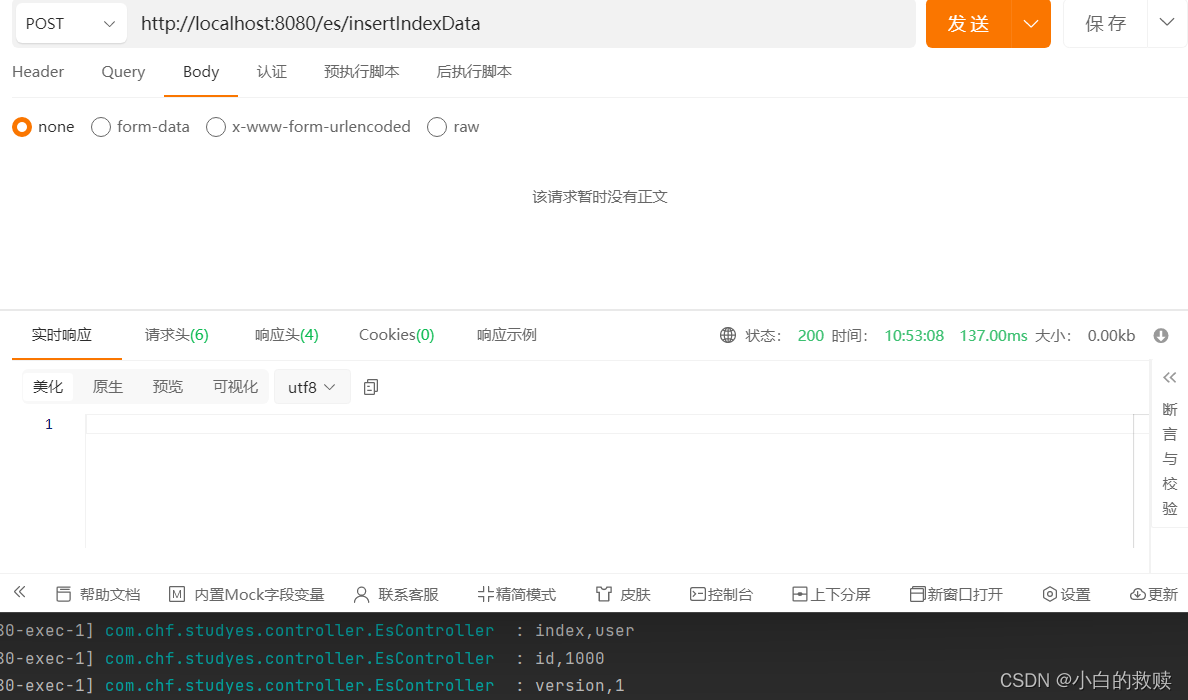
批量添加索引数据
BulkRequest包含一组操作,每个操作都是具有多个变体的类型。为了创建这个请求,可以方便地将构建器对象用于主请求,并将流利的DSL用于每个操作。下面的示例显示了如何为列表或应用程序对象编制索引。
operations是BulkOperation的生成器,BulkOperation是一种变体类型。此类型具有索引、创建、更新和删除变体。
/**
* 批量插入索引数据
*/
@PostMapping("/batchInsertIndex")
public void batchInsertIndex() throws IOException {
// 将需要批量添加的数据放到List中
List<User> list = new ArrayList<>();
list.add(new User("liSi","女",20));
list.add(new User("wangWu","男",22));
// 使用BulkRequest的构造器
BulkRequest.Builder request = new BulkRequest.Builder();
for(User user : list) {
request.operations(l -> l
.index(i -> i
.index("user")
.document(user)
)
);
}
BulkResponse response = elasticConfig.esClient().bulk(request.build());
if(response.errors()) {
log.info("批量插入报错");
} else {
log.info("批量插入成功");
}
}
批量删除索引数据
/**
* 批量删除索引数据
*/
@DeleteMapping("/batchDeleteIndex")
public void batchDeleteIndex() throws IOException {
BulkRequest.Builder request = new BulkRequest.Builder();
// 根据id做到删除索引的数据
request.operations(l -> l
.delete(i -> i
.index("user")
.id("vGK5sogBM87kk5Mw8V0P")
)
);
request.operations(l -> l
.delete(i -> i
.index("user")
.id("u2K5sogBM87kk5Mw8V0P")
)
);
BulkResponse response = elasticConfig.esClient().bulk(request.build());
if(response.errors()) {
log.info("批量删除报错");
} else {
log.info("批量删除成功");
}
}
这里批量删除接口测试完后,我又批量添加了几行数据,方便下面方法的测试。
// 以下就是我添加的数据
list.add(new User("liSi","女",20));
list.add(new User("wangWu","男",22));
list.add(new User("zhaoLiu","男",20));
list.add(new User("xiaoQi","女",21));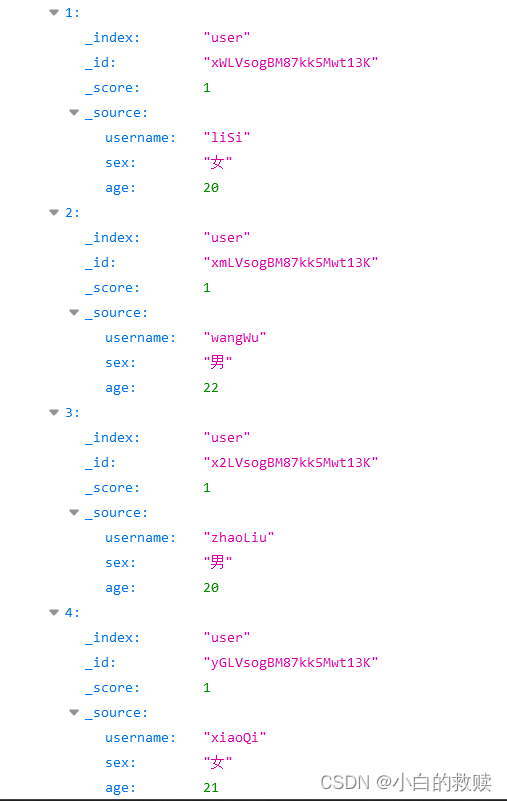
简单查询/单条件
可以组合多种类型的搜索查询。我们将从简单的文本匹配查询开始。单条件准确查询主要用到的关键字是term。而模糊查询就需要用到match。而match这里就不演示了。
/**
* 单条件查询
*/
@GetMapping("/search")
public void search() throws IOException {
SearchResponse<User> response = elasticConfig.esClient().search(s -> s
.index("user")
.query(q -> q
.term(e -> e
.field("age")
.value("20")
)
), User.class
);
// 获取查询后的命中条数:其中包括 TotalHitsRelation 以及 total
TotalHits total = response.hits().total();
boolean isExactResult = total.relation() == TotalHitsRelation.Eq;
if (isExactResult) {
log.info("There are " + total.value() + " results");
} else {
log.info("There are more than " + total.value() + " results");
}
// 解析查询到的所有信息
List<Hit<User>> hits = response.hits().hits();
for(Hit<User> hit : hits) {
log.info("id,{}", hit.id());
}
}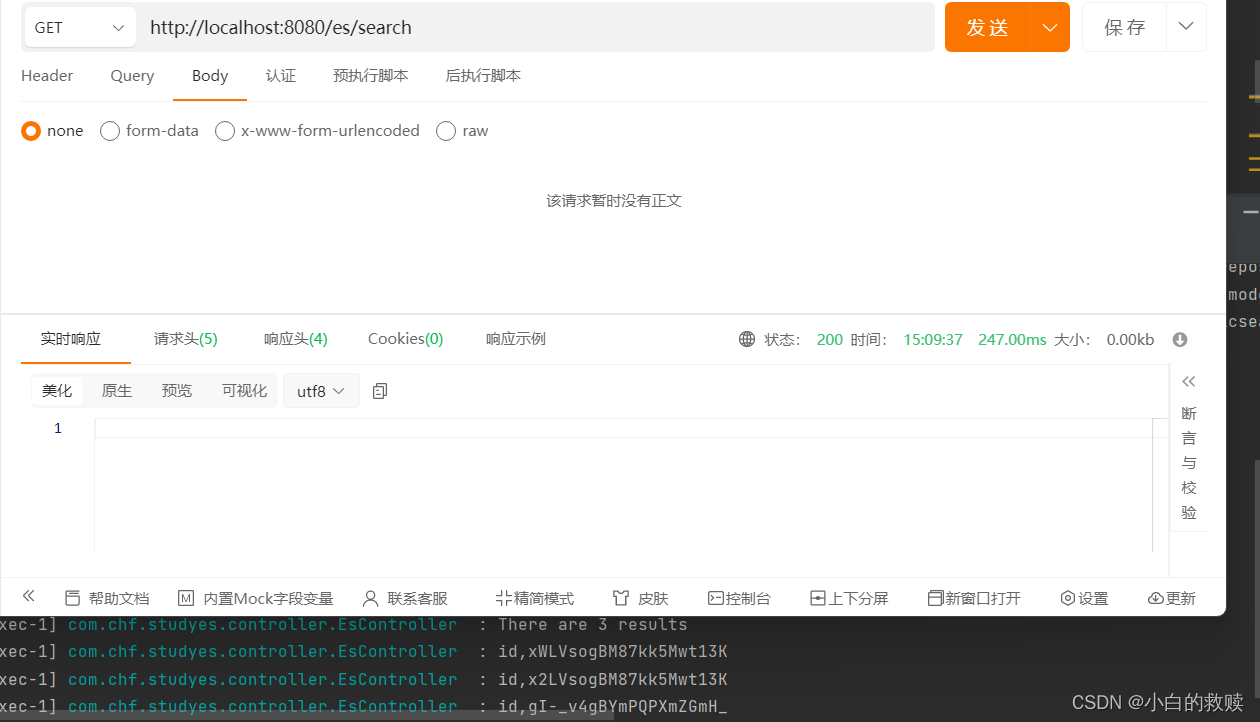
多条件查询 / 范围查询
Elasticsearch允许将单个查询组合起来,以构建更复杂的搜索请求。当前数据有五条,为了更好的多条件查询,我又增加了5条数据。多条件查询用到的关键字主要就是bool。
// 起初的5条数据
list.add(new User("zhangSan","男",18));
list.add(new User("liSi","女",20));
list.add(new User("wangWu","男",22));
list.add(new User("zhaoLiu","男",20));
list.add(new User("xiaoQi","女",21));
// 以下就是我添加的数据
list.add(new User("zhangSan","男",20));
list.add(new User("zhangSan","男",21));
list.add(new User("zhangSan","男",22));
list.add(new User("zhangSan","男",23));
list.add(new User("zhangSan","男",24));/**
* 多条件查询
*/
@GetMapping("/batchSearch")
public void batchSearch() throws IOException {
// 查询性别
Query sex = MatchQuery.of(m -> m
.field("sex")
.query("男")
)._toQuery();
// 查询年龄区间
Query age = RangeQuery.of(r -> r
.field("age")
.lte(JsonData.of(20))
.gte(JsonData.of(18))
)._toQuery();
// 结合性别和年龄区间查询来搜索用户索引
SearchResponse<User> response = elasticConfig.esClient().search(s -> s
.index("user")
.query(q -> q
.bool(b -> b
.must(sex)
.must(age)
)
),User.class
);
// 获取查询后的命中条数:其中包括 TotalHitsRelation 以及 total
TotalHits total = response.hits().total();
boolean isExactResult = total.relation() == TotalHitsRelation.Eq;
if (isExactResult) {
log.info("There are " + total.value() + " results");
} else {
log.info("There are more than " + total.value() + " results");
}
// 解析查询到的所有信息
List<Hit<User>> hits = response.hits().hits();
for(Hit<User> hit : hits) {
log.info("id,{}", hit.id());
}
}
分页查询
主要就是Elasticsearch语法中的from与size表示:当前页的开始索引处以及每页条数。
/**
* 分页查询
*/
@GetMapping("/searchByPage")
public void searchByPage() throws IOException {
// 假设每页3条数据 那么查询第二页的参数就是:开始索引处为(2 - 1) * 3 = 3 以及 每页条数3
SearchResponse<User> response = elasticConfig.esClient().search(b -> b
.index("user")
.from(3)
.size(3)
,User.class
);
log.info("查询到的总条数为,{}",response.hits().total().value());
List<Hit<User>> hits = response.hits().hits();
for(Hit<User> hit : hits) {
log.info("查询到的id,{}", hit.id());
}
}
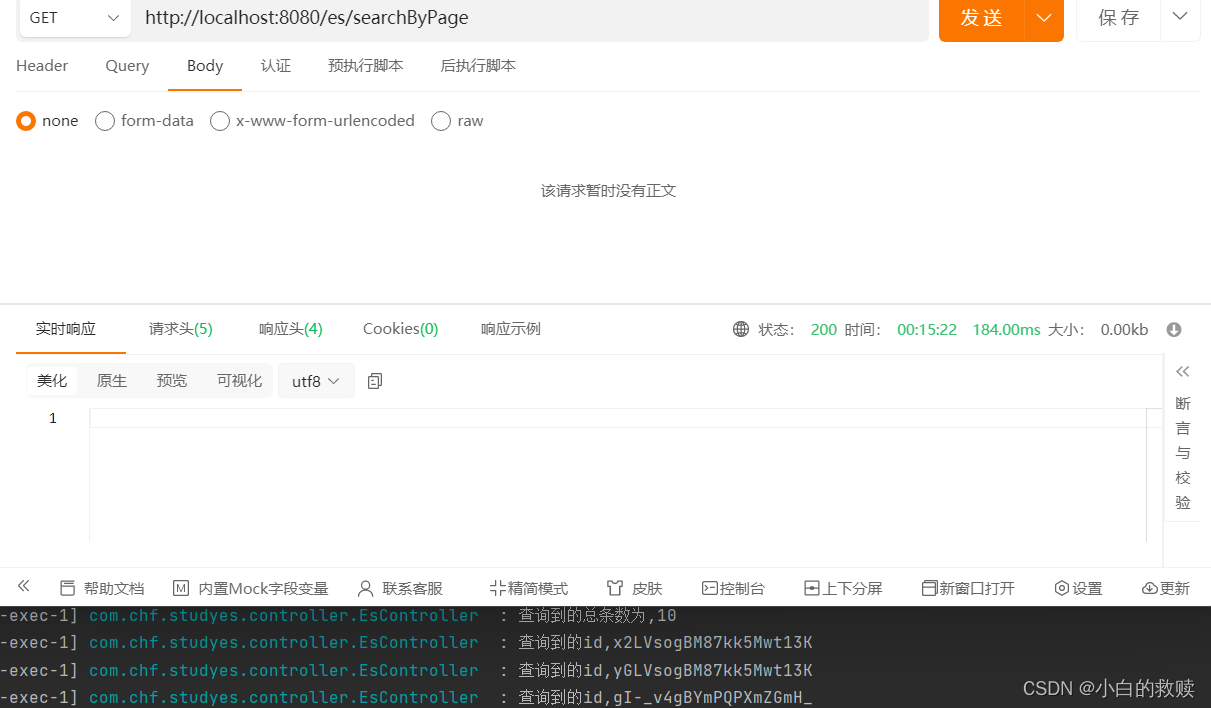
查询所有索引数据
/**
* get all index data
*/
@GetMapping("/getAllIndex")
public void getAllIndex() throws IOException {
SearchResponse<User> response = elasticConfig.esClient().search(s -> s
.index("user")
,User.class);
// 解析查询到的所有信息
List<Hit<User>> hits = response.hits().hits();
for(Hit<User> hit : hits) {
log.info(String.valueOf(hit.source()));
}
}







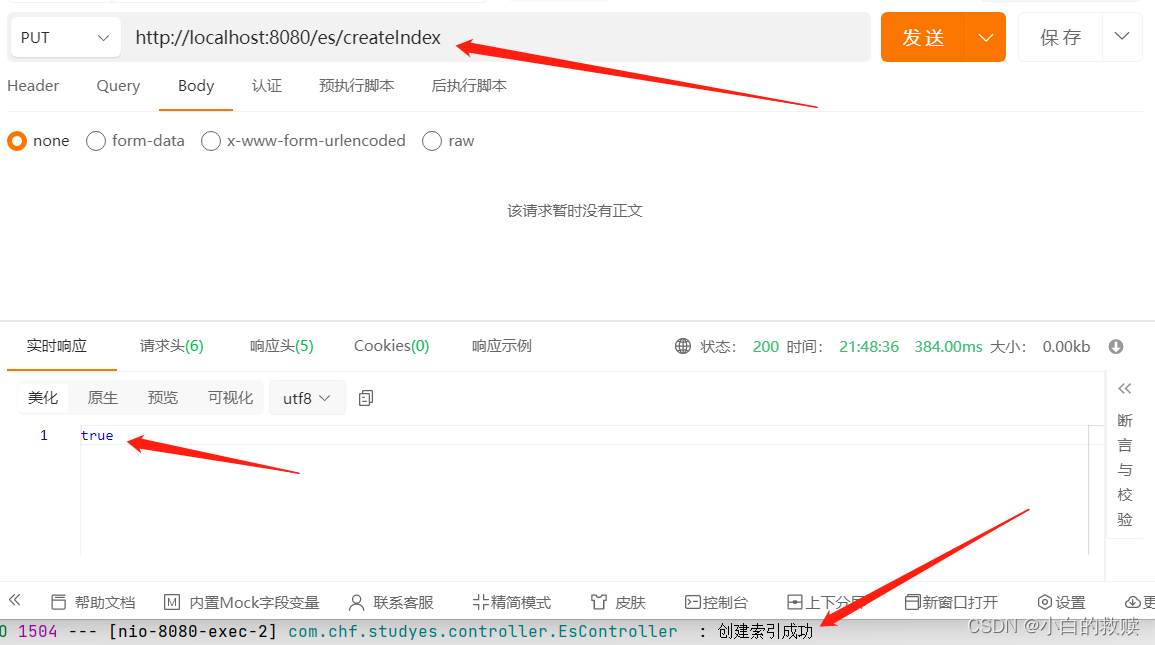
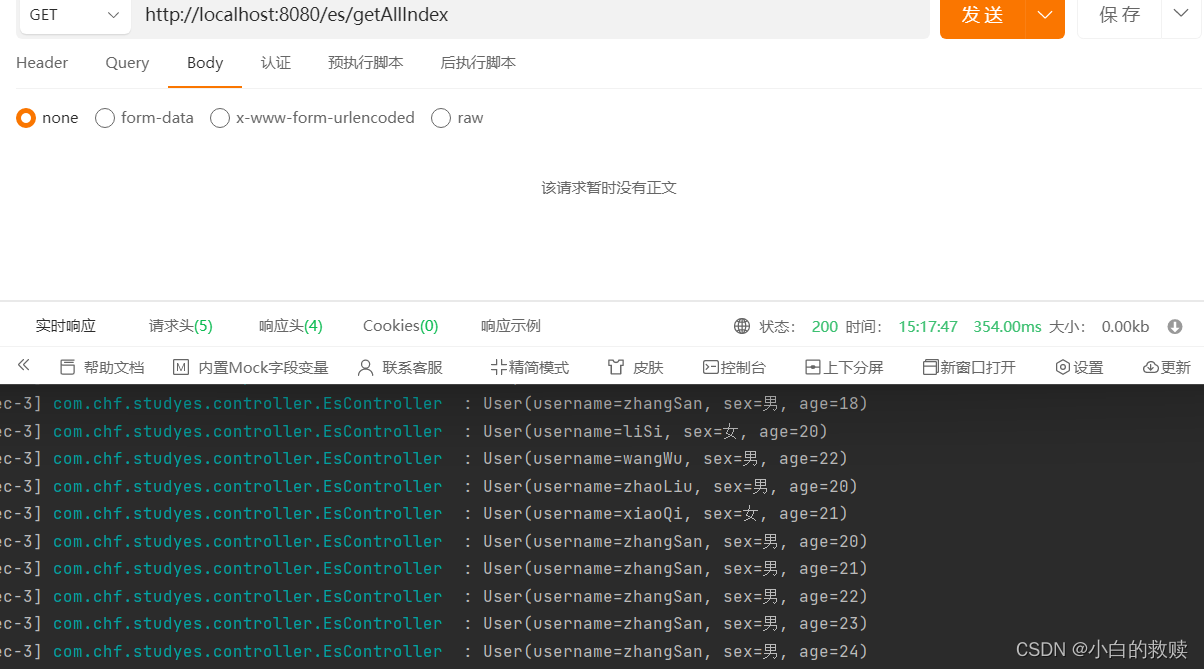














 810
810











 被折叠的 条评论
为什么被折叠?
被折叠的 条评论
为什么被折叠?








